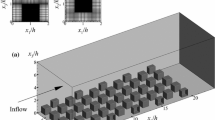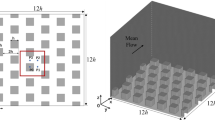Abstract
A simulation tool has been developed to model the wind fields, turbulence fields, and the dispersion of Chemical, Biological, Radiological and Nuclear (CBRN) substances in urban areas on the building to city blocks scale. A Computational Fluid Dynamics (CFD) approach has been taken that naturally accounts for critical flow and dispersion processes in urban areas, such as channeling, lofting, vertical mixing and turbulence, by solving the steady-state, Reynolds-Averaged Navier–Stokes (RANS) equations. Rapid generation of high quality cityscape volume meshes is attained by a unique voxel-based model generator that directly interfaces with common Geographic Information Systems (GIS) file formats. The flow and turbulence fields are obtained by solving the steady-state RANS equations using a collocated, pressure-based approach formulated for unstructured and polyhedral mesh elements. Turbulence modeling is based upon the Renormalization Group variant of the k–ε model (k–ε RNG). Neutrally buoyant simulations are made by prescribing velocity boundary condition profiles found by a power–law relationship, while turbulence quantities boundary conditions are defined by a prescribed mixing length in conjunction with the assumption of turbulence equilibrium. Dispersion fields are computed by solving an unsteady transport equation of a dilute gas, formulated in a Eulerian framework, using the velocity and turbulence fields found from the steady-state RANS solution. In this paper the model is explained and detailed comparisons of predicted to experimentally obtained velocity, turbulence and dispersion fields are made to neutrally stable wind tunnel and hydraulic flume experiments.
Similar content being viewed by others
References
InstitutionalAuthorNameNational Research Council of the National Academies (2003) Tracking and Predicting the Atmospheric Dispersion of Hazardous Material Releases: Implications for Homeland Security National Academic Press Washington DC
Sykes R.I., Henn D.S., Parker S.F., Gabruk R.S.: SCIPUFF – A generalized hazard dispersion model, American Meteorological Society, 9th Joint Conference on Air Pollution Meteorology.
R.I. Sykes R.S. Gabruk (1996) ArticleTitleA second-order closure model for the effect of averaging time on turbulent plume dispersion J. Appl. Meteorol. 36 1038–1045
Lee, R.W. (2002). Moving the Hazard Prediction and Assessment Capability to a Distributed, Portable Architecture, prepared by Oak Ridge National Laboratory for U.S. Dept. of Energy, ORNL/TM-2002–145.
T.J. Bauer R.L. Gibbs (1996) Software Users Manual for the ChemicallBiological Agent Vapor, Liquid and Solid Tracking (VLSTRACK) Computer Model Naval Surface Warfare Center Dahlgren Division Dalgren VA 224485100
Chang, J.C.: 1998, Evaluation of VLSTRACK with the Prairie Grass Field Data.
U.S. Environmental Protection Agency: 2003, AERMOD: latest features and evaluation results, EPA-454/R-03–003.
Hanna, S.R., Briggs, G.A. and Hosker, Jr. R.P.: 1982, Handbook on atmospheric diffusion, U.S. Dept of Energy, Technical Information Center DOE/TIC-11223.
K.B. Schnelle (1987) Atmospheric Diffusion Modeling, Encyclopedia of Physical Science and Technology NumberInSeriesvol. 2 Academic Press Inc. Newyork 192–212
Decroix, D.S.: 2002, Large eddy simulation of urban dispersion during the URBAN2000 field program IOP-10, American Meteorological Society, 4th Symposium on the Urban Environment, pp. J30–J31.
D.J. Hall A.M. Spanton R.W. Macdonald S. Walker (1997) A simple model for estimating dispersion in urban areas, Report CR 169/97, prepared for DERA Porton Down Building Research Establishment Garston Watford, UK
Hall D.J., Spanton A.M., Griffiths I.H., The UDM: A puff model for estimating dispersion in urban areas, In: 7th International Conference or Harmunisation within Atmospheric Dispersion Modeling for Regulatory Purposes, pp. 256–260.
R. Rockle (1990) Bestimmung der Stomungsverhaltnisse, im Bereich komplexer Bebauunsstrukturen Vom Fachbereich Mechanik, der Technischen Hochschule Darmstadt Germany
Pardyjak E.R., Brown M.J., Bagal N.: Improved velocity deficit parameterizations for a fast response urban wind model, American Meteorological Society, Symposium on Planning, Nowcasting, and Forecasting in the Urban Zone.
Bagal, N., Pardyjak, E.R. and Brown, M.J.: Improved upwind cavity parameterization for a fast response urban wind model, American Meteorological Society, Symposium on Planning, Nowcasting, and Forecasting in the Urban Zone.
P.A. Taylor J.R. Salmon (1993) ArticleTitleA model for the correction of surface wind data for sheltering by upwind obstacles J. Appl. Meteor. 49 226–239
H. Kaplan N. Dinar (1996) ArticleTitleA Lagrangian dispersion model for calculating concentration distribution within a built-up domain Atmos. Environ. 30 4197–4207 Occurrence Handle10.1016/1352-2310(96)00144-6 Occurrence Handle1:CAS:528:DyaK28XmtFaqsL4%3D
C.F. Ratto R. Festa C. Romeo O.A. Frumento M. Galluzzi (1994) ArticleTitleMass-consistent models for wind fields over complex terrain: the state of the art Environ. Software 9 247–268
Lim, D.W., Henn, D.S. and Sykes R.I.: 2003, UWM Technical Documentation (version 0.1). Titan Research and Technology Division, Titan Corporation.
Henn Douglas R. Sykes (1999) ArticleTitleLarge-eddy simulation of flow over wavy surfaces J. Fluid Mech. 38 75–112
Lee R.L, Calhoun R.J., Chan S.T., Leone Jr., J., Shinn J. and Stevens, D.E.: Urban dispersion CFD modeling, fact or fiction? 84th AMS Meeting, 3rd Symposium on Urban Environment.
Brown, M., Reisner, J., Smith, S. and Langley, D.: 2001, High Fidelity Urban Scale Modeling, Los Alamos National Laboratory, LA-UR-01–1422.
Calhoun, C., Chan, S., Gouveia, F., Lee, R., Leone, J., Shinn, J. and Stevens, D.: 1999, Flow Around a Complex Building: Comparisons Between Experimental and Modeled results, US Dept. of Energy, UCRL-ID-137240.
H.W. Krus J.O. Haanstra R. Hamm Particlevan der B. Schruer (2003) ArticleTitleNumerical simulations of wind measurements at Amsterdam Airport Schiphol J. Wind Eng. Ind. Aerodynam. 91 1215–1223
A. Riddle D. Carruthers A. Sharpe C. McHugh J. Stocker (2004) ArticleTitleComparisons between FLUENT and ADMS for atmospheric dispersion modeling Atmos. Environ. 38 1029–1038 Occurrence Handle10.1016/j.atmosenv.2003.10.052 Occurrence Handle1:CAS:528:DC%2BD2cXktlWisA%3D%3D
Tehranian, S., Hanna, S., Lohner, R. and Carissimo, B.: The numerical simulation of airflow and near-field dispersion around single buildings: several test cases, J. Wind Eng. Ind. Aerodynam. (in revision).
B.Z. Cybyk J.P. Boris T.R. Young M.H. Emery S.A. Cheatham (2001) Simulation of fluid dynamics around complex urban geometries, 30th AIAA Aerospace Sciences Meeting and Exhibit, AIAA-01–0803 Reno NV
Cybyk B.Z., Boris J.P., Young T.R., Lind C.A., Landsberg A.M. (1999). A detailed contaminant transport model for facility hazard assessment in urban areas, 30th Plasmadynamics and Lasers Conference, AIAA-99–3441, Norfolk, VA.
A. Sagrado J. Breeck P. Rambaud D. Olivari (2002) ArticleTitleNumerical and experimental modeling of pollutant dispersion in a street canyon J. Wind Eng. Ind. Aerodynam. 90 321–339
Y. Cheng F.S. Lien E. Yee R. Sinclair (2003) ArticleTitleA comparison of large eddy simulations with a standard k–ε Reynolds-averaged Navier–Stokes model for the prediction of a fully developed turbulent flow over a matrix of cubes J. Wind Eng. Ind. Aerodynam. 91 1301–1328
K. Nozawa T. Tamura (2002) ArticleTitleLarge eddy simulation of the flow around a low-rise building immersed in a rough-wall turbulent boundary layer J. Wind Eng. Ind. Aerodynam. 90 1151–1162
Daish, N.C., Britter, R.E., Linden, P.F., Jagger, S.F., and Carissimo B.: 1998, SMEDIS: scientific model evaluation of dense gas dispersion models, proceedings, 5th International Conference on Harmunization with Atmospheric Dispersion Modelling for Regulatory Purposes, Rhodes, Greece.
B. Carissimo S.F. Jagger N.C. Daish A. Halford S. Selmer-Olsen K. Riikonen J.M. Perroux J. Wurtz J. Bartzis N.J. Duijm K. Ham M. Schatzmann R. Hall (2001) ArticleTitleThe SMEDIS Database and Validation Exercise Int. J. Environ. Pollut. 2001. 16 IssueID1/2/3/4/5/6 614–649 Occurrence Handle1:CAS:528:DC%2BD38XjsFGgurw%3D
J.C. Weil R.I. Sykes A. Venkatram (1992) ArticleTitleEvaluating air-quality models: review and outlook J. Appl. Meteorol. 31 1121–1145 Occurrence Handle10.1175/1520-0450(1992)031<1121:EAQMRA>2.0.CO;2
Easom, G.: 2000, Improved Turbulence Models for Computational Wind Engineering, PhD Thesis, University of Nottingham.
Mestayer, P.G., Sini, J.F., Rey, C., Anquentin, S., Kusuma Badri, S.M. and Lakehal, D.: Pollutant dispersion in the urban atmosphere: simulation of the turbulent flows using a k–ε model, ERCOFTAC Bull., 22–28.
Coirier, W.J., Fricker, D.M. and Furmanczyk, M.: 2003, Development of a High Fidelity PC Based Simulator for Modeling the Atmospheric Transport and Dispersion of Nuclear, Chemical, Biological and Radiological Substances in Urban Areas, DTRA SBIR Phase II Final Report: Contract: DTRAA01–01–0079.
Jiang, Y., Fricker, D.M. and Coirier, W.J.: 1999, Parallelization of a fully implicit unstructured pressure-based flow solver using MPI, AIAA-99–3274.
D.A. Anderson J.C. Tannehill R.H. Pletcher (1984) Computational Fluid Mechanics and Heat Transfer Hemisphere New York
B.E. Launder D.B. Spalding (1974) ArticleTitleThe numerical computation of turbulent flows Comp. Methods. Appl. Mech. Eng. 3 269–289 Occurrence Handle10.1016/0045-7825(74)90029-2
H.W. Dettering D. Etling (1985) ArticleTitleApplication of the e–ε turbulence model to the atmospheric boundary layer Boundary Layer Meteorol. 33 113–133
Yakhot, A., Orszag, S.A. and Yakhot, V: 1989, Numerical Modeling of Turbulence and Combustion Processes in Strongly Separated, Non-stationary Flows, Final Report NASA Contract: NAS3–25604.
V. Yakhot S.A. Orszag S. Thangam T.B. Gatski C.G. Speziale (1992) ArticleTitleDevelopment of turbulence models for shear flows by a double expansion technique Phys. Fluids A. 4 1510–1520 Occurrence Handle10.1063/1.858424 Occurrence Handle1:CAS:528:DyaK38Xkslagurs%3D
H. Schlichting (1979) Boundary Layer Theory EditionNumber7 McGraw-Hill New York
J.R. Shewchuk (1996) Triangle: Engineering a 2D Quality Mesh Generator and Delaunay Triangulator First Workshop on Applied Computational Geometry ACM
J. Ruppert (1995) ArticleTitleA Delaunay refinement algorithm for quality 2-dimensional mesh generation J. Algorithms. 18 IssueID3 548–585 Occurrence Handle10.1006/jagm.1995.1021
J.R. Shewchuk (1996) ArticleTitleAdaptive precision floating-point arithmetic and fast robust geometric predicates J. Discrete Comput. Geometry. 18 IssueID3 305–363
CFD-ACE+, V2003 Users Manual, volumes 1 and 2.
Jiang, Y. and Przekwas, A.J.: 1994, Implicit, pressure-based incompressible Navier-Stokes solver for unstructured meshes, AIAA-94–0303.
Athavale, M.M., Jiang, Y. and Przekwas, A.J.: 1995, Application of an unstructured grid solution methodology to turbomachinery flows, AIAA-95–0174.
G. Karypis K. Kumar (1998) ArticleTitleMultilevel K-way partitioning scheme for irregular graphs J. Parallel Distributed Comput. 48 IssueID1 96–129
Macdonald, R., Carter, S. and Slawson, P.R.: 2000, Measurements of Mean Velocity and Turbulence Statistics in Simple Obstacle Arrays at 1:200 Scale, University of Waterloo, Thermal Fluids Report 2000–1, Rev. 2.
Macdonald, R., Carter, S. and Slawson, P.R.: 2001, Measurements of Mean plume Dispersion in Simple Obstacle Arrays at 1:200 Scale, University of Waterloo, Thermal Fluids Report 2001–2.
Brown, M.J., Lawson, R.E., DeCroix, D.S. and Lee, R.L.: 1999, Mean flow and turbulence measurements around a 2-D array of buildings in a wind tunnel, LA-UR-99–5395.
Brown, M.J., Lawson, R.E., DeCroix, D.S. and Lee, R.L.: 2001, Comparison of centerline velocity measurements obtained around 2D and 3D building arrays in a wind tunnel, LA-UR-01–4138.
M. Ciofalo M.W. Collins (1989) ArticleTitlek–ε predictions of heat transfer in turbulent recirculating flows using an improved wall treatment Numer. Heat Transfer B. 15 21–47
Author information
Authors and Affiliations
Corresponding author
Rights and permissions
About this article
Cite this article
Coirier, W.J., Fricker, D.M., Furmanczyk, M. et al. A Computational Fluid Dynamics Approach for Urban Area Transport and Dispersion Modeling. Environ Fluid Mech 5, 443–479 (2005). https://doi.org/10.1007/s10652-005-0299-4
Received:
Accepted:
Published:
Issue Date:
DOI: https://doi.org/10.1007/s10652-005-0299-4




